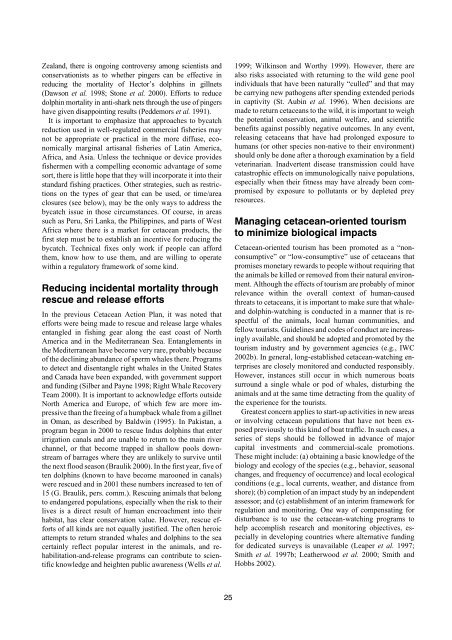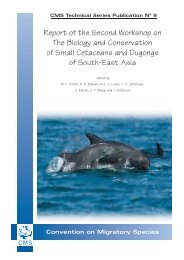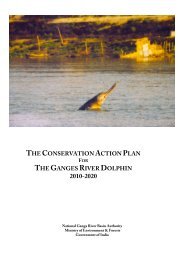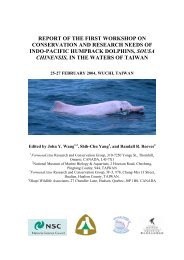Dolphins, Whales and Porpoises: 2002-2010 Conservation - IUCN
Dolphins, Whales and Porpoises: 2002-2010 Conservation - IUCN
Dolphins, Whales and Porpoises: 2002-2010 Conservation - IUCN
Create successful ePaper yourself
Turn your PDF publications into a flip-book with our unique Google optimized e-Paper software.
Zeal<strong>and</strong>, there is ongoing controversy among scientists <strong>and</strong><br />
conservationists as to whether pingers can be effective in<br />
reducing the mortality of Hector’s dolphins in gillnets<br />
(Dawson et al. 1998; Stone et al. 2000). Efforts to reduce<br />
dolphin mortality in anti-shark nets through the use of pingers<br />
have given disappointing results (Peddemors et al. 1991).<br />
It is important to emphasize that approaches to bycatch<br />
reduction used in well-regulated commercial fisheries may<br />
not be appropriate or practical in the more diffuse, economically<br />
marginal artisanal fisheries of Latin America,<br />
Africa, <strong>and</strong> Asia. Unless the technique or device provides<br />
fishermen with a compelling economic advantage of some<br />
sort, there is little hope that they will incorporate it into their<br />
st<strong>and</strong>ard fishing practices. Other strategies, such as restrictions<br />
on the types of gear that can be used, or time/area<br />
closures (see below), may be the only ways to address the<br />
bycatch issue in those circumstances. Of course, in areas<br />
such as Peru, Sri Lanka, the Philippines, <strong>and</strong> parts of West<br />
Africa where there is a market for cetacean products, the<br />
first step must be to establish an incentive for reducing the<br />
bycatch. Technical fixes only work if people can afford<br />
them, know how to use them, <strong>and</strong> are willing to operate<br />
within a regulatory framework of some kind.<br />
Reducing incidental mortality through<br />
rescue <strong>and</strong> release efforts<br />
In the previous Cetacean Action Plan, it was noted that<br />
efforts were being made to rescue <strong>and</strong> release large whales<br />
entangled in fishing gear along the east coast of North<br />
America <strong>and</strong> in the Mediterranean Sea. Entanglements in<br />
the Mediterranean have become very rare, probably because<br />
of the declining abundance of sperm whales there. Programs<br />
to detect <strong>and</strong> disentangle right whales in the United States<br />
<strong>and</strong> Canada have been exp<strong>and</strong>ed, with government support<br />
<strong>and</strong> funding (Silber <strong>and</strong> Payne 1998; Right Whale Recovery<br />
Team 2000). It is important to acknowledge efforts outside<br />
North America <strong>and</strong> Europe, of which few are more impressive<br />
than the freeing of a humpback whale from a gillnet<br />
in Oman, as described by Baldwin (1995). In Pakistan, a<br />
program began in 2000 to rescue Indus dolphins that enter<br />
irrigation canals <strong>and</strong> are unable to return to the main river<br />
channel, or that become trapped in shallow pools downstream<br />
of barrages where they are unlikely to survive until<br />
the next flood season (Braulik 2000). In the first year, five of<br />
ten dolphins (known to have become marooned in canals)<br />
were rescued <strong>and</strong> in 2001 these numbers increased to ten of<br />
15 (G. Braulik, pers. comm.). Rescuing animals that belong<br />
to endangered populations, especially when the risk to their<br />
lives is a direct result of human encroachment into their<br />
habitat, has clear conservation value. However, rescue efforts<br />
of all kinds are not equally justified. The often heroic<br />
attempts to return str<strong>and</strong>ed whales <strong>and</strong> dolphins to the sea<br />
certainly reflect popular interest in the animals, <strong>and</strong> rehabilitation-<strong>and</strong>-release<br />
programs can contribute to scientific<br />
knowledge <strong>and</strong> heighten public awareness (Wells et al.<br />
1999; Wilkinson <strong>and</strong> Worthy 1999). However, there are<br />
also risks associated with returning to the wild gene pool<br />
individuals that have been naturally “culled” <strong>and</strong> that may<br />
be carrying new pathogens after spending extended periods<br />
in captivity (St. Aubin et al. 1996). When decisions are<br />
made to return cetaceans to the wild, it is important to weigh<br />
the potential conservation, animal welfare, <strong>and</strong> scientific<br />
benefits against possibly negative outcomes. In any event,<br />
releasing cetaceans that have had prolonged exposure to<br />
humans (or other species non-native to their environment)<br />
should only be done after a thorough examination by a field<br />
veterinarian. Inadvertent disease transmission could have<br />
catastrophic effects on immunologically naive populations,<br />
especially when their fitness may have already been compromised<br />
by exposure to pollutants or by depleted prey<br />
resources.<br />
Managing cetacean-oriented tourism<br />
to minimize biological impacts<br />
Cetacean-oriented tourism has been promoted as a “nonconsumptive”<br />
or “low-consumptive” use of cetaceans that<br />
promises monetary rewards to people without requiring that<br />
the animals be killed or removed from their natural environment.<br />
Although the effects of tourism are probably of minor<br />
relevance within the overall context of human-caused<br />
threats to cetaceans, it is important to make sure that whale<strong>and</strong><br />
dolphin-watching is conducted in a manner that is respectful<br />
of the animals, local human communities, <strong>and</strong><br />
fellow tourists. Guidelines <strong>and</strong> codes of conduct are increasingly<br />
available, <strong>and</strong> should be adopted <strong>and</strong> promoted by the<br />
tourism industry <strong>and</strong> by government agencies (e.g., IWC<br />
<strong>2002</strong>b). In general, long-established cetacean-watching enterprises<br />
are closely monitored <strong>and</strong> conducted responsibly.<br />
However, instances still occur in which numerous boats<br />
surround a single whale or pod of whales, disturbing the<br />
animals <strong>and</strong> at the same time detracting from the quality of<br />
the experience for the tourists.<br />
Greatest concern applies to start-up activities in new areas<br />
or involving cetacean populations that have not been exposed<br />
previously to this kind of boat traffic. In such cases, a<br />
series of steps should be followed in advance of major<br />
capital investments <strong>and</strong> commercial-scale promotions.<br />
These might include: (a) obtaining a basic knowledge of the<br />
biology <strong>and</strong> ecology of the species (e.g., behavior, seasonal<br />
changes, <strong>and</strong> frequency of occurrence) <strong>and</strong> local ecological<br />
conditions (e.g., local currents, weather, <strong>and</strong> distance from<br />
shore); (b) completion of an impact study by an independent<br />
assessor; <strong>and</strong> (c) establishment of an interim framework for<br />
regulation <strong>and</strong> monitoring. One way of compensating for<br />
disturbance is to use the cetacean-watching programs to<br />
help accomplish research <strong>and</strong> monitoring objectives, especially<br />
in developing countries where alternative funding<br />
for dedicated surveys is unavailable (Leaper et al. 1997;<br />
Smith et al. 1997b; Leatherwood et al. 2000; Smith <strong>and</strong><br />
Hobbs <strong>2002</strong>).<br />
25





